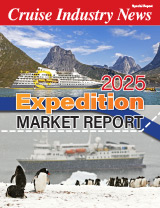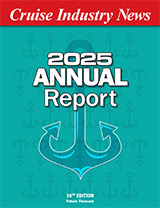Cunard’s comeback will be “unbelievable,” promised Larry Pimentel, president of the new Cunard Line, after five months of hectic activities, including consolidation of offices in Miami, redefining the brand identities of Cunard Line and Seabourn Cruise Line, planning to redesign the existing ships, and building a new liner, the so-called Queen Mary project.
In the short term, Cunard’s recently announced “Simplicity Pricing” has created a “wave month” in December, according to Pimentel, who said 1999 was the year of opportunity and was urging people to “book (Cunard) now, because prices will never be better.”
“I am going for revenue in this year of transition,” Pimentel said, “and exposure of the product.”
Acquisition and Merger
Carnival Corporation bought Cunard for its brand name, which has worldwide recognition, Pimentel said, and not for its “eclectic mix of ships that did not quite fit.” Also, during the due diligence process, Pimentel said he discovered reporting lines and processes at Cunard that did not make any sense whatsoever. Thus some major changes were called for.
“The acquisition was fun, but the merger has been hell,” Pimentel said, referring to the redundancies of positions which necessitated job cuts. The closing of Seabourn’s San Francisco office was tough for Pimentel, who noted that only 23 people from Seabourn are moving to Miami. But the consolidation of offices in Miami was the proper decision to make, Pimentel underscored, because a lot of back-office functions are now shared with the parent company, Carnival Corp.; because the company’s ships call more on the East Coast than the West Coast; and because all the vendors serving the cruise line are around Miami.
All purchasing has been transferred to Carnival Corporation which has hired most of the 12 purchasing staff members that were let go, according to Pimentel.
When fully up and running, Cunard Line will have about 400 employees in Miami plus another 100 employees in Southampton covering sales and marketing for the U.K. and continental Europe, fleet management (shipboard personnel recruitment) and computer services. Additional offices are in Oslo and Hamburg.
Transition Year
Pimentel will use 1999 to reposition the ships and the brands in their respective markets, to carry out physical redesign work on the existing ships, to pen the Queen Mary contract, and to firm up a new pricing structure.
The work is slated to be completed by the end of 1999. Thus, the year 2000 will be the first when the company will operate clearly under the Cunard Line umbrella.
The redesign of the ships will come at a price tag ranging from $55 million to $75 million and include the interior redesign of the QE2 in 1999. Tillberg Design is responsible for the design concept. The Swedish firm will also carry out a redesign of the Caronia (Vistafjord), while the Greek design firm of A&M Katzourakis has been assigned the Seabourn Sun (Royal Viking Sun).
The work is necessary because the former owners were interested in selling the ships and not improving them, Pimentel said.
In addition, Pimentel explained that the company is studying the feasibility of adding verandas to the Seabourn Legend, Pride and Spiririt.
Queen Mary
The Queen Mary project will be an ocean liner, according to Pimentel, as distinguished from a cruise ship concept. That means a high-speed, deep-hull ship, capable of crossing the Atlantic comfortably in six days, Pimentel explained.
He noted that crossings would not just be between New York and Southampton, but more than likely would be expanded to Boston, Cherbourgh, Le Havre, and other ports.
The new ship will have a retro feel, but will not have an ice-skating rink or a rock-climbing wall, nor will it be about entertainment, Pimentel pointed out, in reference to two other cruise lines’ ships. He also said that the tonnage will be about 110,000, the service speed will be in the high 20s (knots), and the length will be 1,150 feet.
And yes, the ship will have “classes,” but in the clever way that the QE2 has classes, Pimentel said.
(The QE2 links cabin categories to particular restaurants so that the more passengers pay for their cabin, the fancier the restaurant is that they are assigned to.)
In addition, the new ship will have some unique attractions including the world’s largest maritime museum afloat with Cunard items borrowed from a museum in Liverpool, Pimentel said. The ship will also have an English pub, with its own micro-brewery onboard.
The passenger capacity will be in excess of 2,000.
Further details and drawings are expected to be presented next summer and a contract is expected to be signed in 1999, with delivery slated for 2002.
New Cunard
But getting the right ship in the right brand group is not done instantly. It takes time, Pimentel said. Hence, 1999 is a transition year. And he is confident that the combination of the two brands is viable. The combination is also extremely cost effective as Pimentel expects to cut costs by $25 million in 1999.
A new management style is also expected to inspire the company with new energy and enthusiasm.
Notably, the executive team does not include one single member from the old Cunard, but 100 percent of the former Seabourn senior executives are aboard. Pimentel attributed the dramatic departure of all former senior Cunard executives to the differences in company cultures. People develop ways of doing things that are not easily changed, Pimentel said, referring to the Cunard people who left. “Cunard had a lot of talent, but an absence of focus and leadership with eight different CEOs since 1984,” he added.
But the markets will remain the same. The old Cunard sold only 49 percent of its capacity in the United States, while Seabourn sold 84 percent in the United States. Pimentel intends to maintain those ratios. He said that worldwide Cunard is synonymous with luxury and that the new association will also help expose the Seabourn brand worldwide.
And according to Pimentel, Cunard has a tremendous advantage in owning the Seabourn and Sea Goddess vessels, “because no one will ever build this size vessel again.” Building smaller vessels has become prohibitive through the need for having economies of scale, Pimentel said. Meanwhile, the 116-passenger and 220-passenger vessels have become the most charterable vessels in the world and charters were up 150 percent in 1998 compared to 1997, Pimentel said, adding that 1999 was tracking a similar growth pattern.



